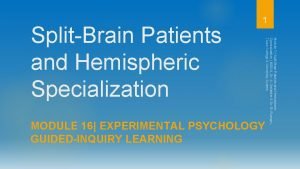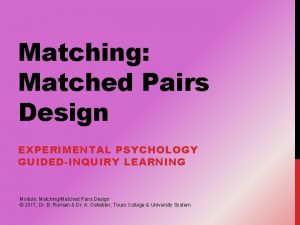Reading a Pie Chart EXPERIMENTAL PSYCHOLOGY GUIDEDINQUIRY LEARNING








- Slides: 8

Reading a Pie Chart EXPERIMENTAL PSYCHOLOGY GUIDED-INQUIRY LEARNING Module: Reading a Pie Chart © 2017, Dr. B. Rumain & Dr. A. Geliebter, Touro College & University System

MOTIVATION We see charts all the time. Yet do we really know how to extract the information from them? This activity gives you practice in reading a pie chart.

LEARNING OBJECTIVE • You will become proficient in reading a pie chart.

MODEL / ACTIVITY Look at the chart below:

This chart deals with psychological characteristics of identical twins raised together. Remember, identical twins have the same DNA so we would expect them to share many characteristics as a result of that.

The chart breaks up the characteristics of identical twins into three clusters: 1. characteristics due to genetics (i. e. , having the same DNA); 2. characteristics due to being raised together in a shared environment (same environment). Here we are talking about twins raised in the same home. So they do many activities together. They would usually go to the same school, be in the same class, share common friends, go to the library together, have access to the same books and participate in the same cultural activities; 3. characteristics due to environmental influences that the twins do not share. Occasionally twins will do things separately. For example, it might be that they do not take all the same classes in school or that they are not friends with exactly the same people.

The chart below gives a breakdown from a hypothetical study of twins’ psychological characteristics.

EXERCISES 1. What proportion of twins’ psychological characteristics, according to the chart, is due to genetics/heredity? 2. What proportion of their psychological characteristics is due to having a shared environment with their twin? 3. What proportion is due to non-shared aspects of their environment? 4. True or false: From the graph, we see that genetics contributes much more strongly to twins’ psychological characteristics than do environmental factors.
 Cara membuat diagram lingkaran di excel
Cara membuat diagram lingkaran di excel Pie chart the great gatsby chapter 9 blame chart answers
Pie chart the great gatsby chapter 9 blame chart answers Experimental vs non experimental
Experimental vs non experimental Descriptive studies
Descriptive studies Experimental vs non experimental research
Experimental vs non experimental research Experimental vs nonexperimental
Experimental vs nonexperimental Experimental vs non experimental
Experimental vs non experimental While reading activities
While reading activities Experimental psychology research topics
Experimental psychology research topics















